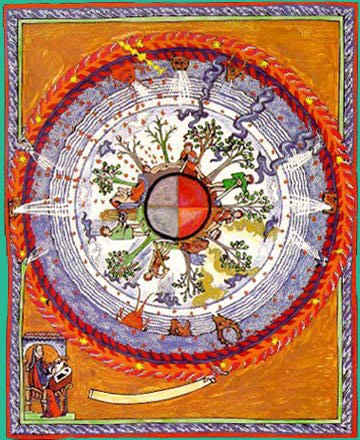 |
| Hildegard receiving a vision, from the Scivas. Yes, that is gold leaf in the background. |
When I started this project I intended the focus to be on women who were primarily two-dimensional artists, with an occasional sculptress thrown in for good measure. With that as my self-appointed mission I originally thought to pass by Hildegard von Bingen. You know, the medieval mystic, scientist, herbalist, doctor, poet and political critic…but artist? I just couldn’t put her in that box.
As I tried to move on to other artists that fit my mold, I kept being pulled back to Hildegard if for no other reason than her general bad-assery (it’s a thing…look it up). For example – did you know that she saw her first vision at the age of three? And those visions continued for much of her life? Or that, at thirteen, she went to live with a religious woman named Jutta of Sponheim who educated her in Latin, scripture, reading and writing. Or, because of the constraints against women’s participation in the church, and likely fear of being seen as mentally ill, she didn’t talk much about her visions until she was 42 years old? (when she did tell it was with what is likely her best known work -- the Scivas (Know the Ways) -- which describes 26 of her most vivid visions. Did you know that when she was sixty, she put undertook lengthy preaching tours, something that was as unusual for a woman then as it would be today? (Hummm….today it would have been a book signing tour for the Scivas)
 |
Illumination from the Scivias,
Cultivating the Cosmic Tree.
Check out the tiny Hildegard in the lower left corner. |
It is the Scivas, along with a series of nine books on the different natures of trees, plants, animals, birds, fish, minerals, and metal that made me pause. The illuminations in these works are amazing. The colors are bright and vibrant. The forms are simple, while the messages sometimes complex. Some scholars believe that these works were illustrated by Hildegard, others think that she had help, but all agree that she served as ‘art director’. Many of the illuminations in the Scivias take the form of mandalas symbolizing the universe, reverence for life and the Divine Presence on Earth.
Around the same time that the Scivias was completed Hildegard also produced one of her more intriguing works. The Ordo Virtutum is a sacred musical drama about the struggle for a human soul, between the Virtues and the Devil. Some scholars have gone as far as to call it opera, and many agree that it was the first morality play in Europe.
Music, art, poetry, and scientific study. Hildegard was definitely ahead of her time, very much a Renaissance woman.
"I, the fiery life of divine essence, am aflame beyond the beauty of the meadows."
Hildegard of Bingen (1098-1179)
No comments:
Post a Comment